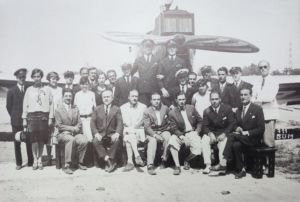
A photographic exhibition dedicated to Renato Morandi has been set up at the ‘arrivals’ terminal of the airport. Engineer Morandi founded the Transadriatica in Ancona, one of the first air carriers in the civil field, later based at the Nicelli airport on the Lido of Venice. This is an exemplary Italian story of those who, with intuition and passion, have been able to lead the country towards the future.
It flew over the skies of Italy in the twenties and with an original and evocative photographic exhibition it has arrived today at Ancona Airport. Renato Morandi, born in Ancona in 1902, is in fact one of the fathers of Italian commercial aviation thanks to the Transadriatica that he founded in Ancona in the mid-twenties, one of the first companies born in the country with an operational base at the Nicelli airport on the Lido of Venice.
Engeneer Morandi was born in the Marche region, although his success with the Transadriatica arrived in the Venetian capital. A series of period shots tell the story of a country that had just emerged from the Great War and was looking for its first forms of modernization. Renato Morandi’s liveliness and his spirit of initiative made him consecrated as the founder of the first airline that did not use seaplanes, laying the foundations for what would be the development of commercial aviation in Italy. After a period in Germany, where he attended the Junkers aeronautical plants, acquiring fundamental experiences, once back at Ancona, he founded with his brother Mario and the support of his family, the Società Anonima di Navigazione Aerea Transadriatica, then transferred to the Lido of Venice where mechanical workers could develop his project. Morandi’s is undoubtedly a pioneering enterprise, a mixture of brilliant intuitions and fortunate encounters that in the only four years led him to opem a considerable number of routes, in Italy and Europe. Renato Morandi’s enthusiastic run was interrupted in 1930 due to his untimely death due to an accident at Rome’s Littorio airport.
The exhibition brings back this Italian history with shots that faithfully reproduce the climate of an era, the technology that pointed straight towards the future, the awards to the engineer Morandi, such as when in September 1928, the King of Italy Vittorio Emanuele III, on the occasion of a visit to Venice, went to the Lido airport where he reviewed the installations and organization of the Transadriatica, congratulating its founder. In Renato Morandi’s story there is all of Italy in black and white of the twenties like the images of an exhibition that collects Italy’s past a hundred years later.